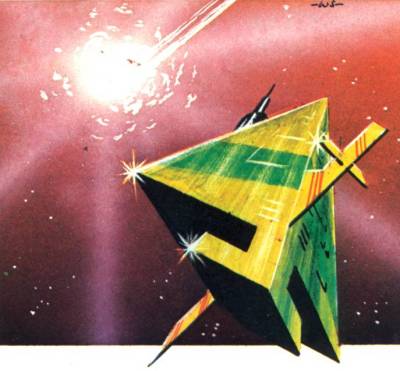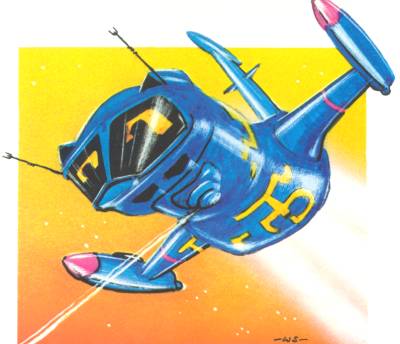| arcade games |
With the Spectrum, program writers have been able to write more complex games. John Gilbert Investigates this new move

ALMOST every major type of arcade game has been simulated on Sinclair computers. There are also new games which have an arcade format but have evolved on a microcomputer. The Spectrum is an ideal machine on which to play arcade games. The quality of them has improved substantially since the launch of the machine. Some of the first arcade games to be produced for the Spectrum were versions of Space Invaders, the game which started the arcade craze.
Spectral Invaders was the first to be announced by Bug Byte, which was already renowned for its arcade and adventure games on the ZX-81. So far it is the game which most closely resembles the original arcade version. Although it is slow it is difficult to score points, as you can fire only one laser blast at a time.
By the time the laser bolt has reached the place where you wanted it to go, the target invader has moved on. That means that a great deal of anticipation and skill is required. Graphically, the Bug Byte invaders is the best, with rows of different-colour aliens crossing the screen and large motherships moving from one side of the screen to the other at random intervals. Spectral Invaders is well-presented and costs £5.95.
Another invaders game, Space Intruders, was launched at about the same time as Spectral Invaders. The game is much faster and is recommended for those who like to keep their fingers on the fire button and amass a big score. The only criticism is that the aliens and mothercraft are very small and the mothership is blue on a black background and so is very difficult to hit. Apart from that Space Intruders from Quicksilva is good value at £5.95.
Namtir Raiders, for the ZX-81, is a space invaders game from Artic Computing with a difference. The player still has to face the hordes of aliens which come down the screen but the laser base can be moved up and down as well as left and right.
The greater movement permitted to the player is compensated by the hail of bombs dropped by the aliens and the size and power of alien ships. There are four waves of aliens and as the game progresses the ships get bigger until the giant mothership arrives.
The player has five laser bases during the game and they can take only five hits from alien bombs. There are three levels of difficulty - easy to impossible. The game, costing £3.95, is addictive and the graphics are neither awkward in design nor jerky in movement.
The game which is gaining popularity with 48K Spectrum owners is Timegate, from Quicksilva. The authors claim that it is the ultimate in 3D arcade space action. The game is loaded in two parts, the first being a lengthy instruction manual. After the manual has finished you can load the game. The object is to destroy a race of aliens called the Squarm who are trying to colonise Earth. To do that the player must fight the enemy in space and go through time by locating a series of Time Gates to find the Squarm's base.
The pleasant thing about the game is its graphics. The player is at the controls of a space fighter and looks out into a 3D representation of space. The enemy fighters are also seen in 3D and so are the planets on which the player can land to refuel and repair the ship. It is by far the best arcade action game so far for the Spectrum and costs only £6.95.
Asteroids is also becoming popular on Sinclair machines. One of the first companies to launch a version for the ZX-81 was Quicksilva. It was a good version on such a small machine and is still proving popular.
Quicksilva has also introduced a Spectrum version called Meteor Storm. It has the added attraction of speech before play. It is difficult to hear the words but we are informed by the authors that it says "Meteor Alert... Meteor Alert...". Meteor Storm is a novel version of Asteroids and costs £5.95.
Sinclair Research has a good game of asteroids, called Planetoids, in its new Spectrum Software library. The asteroids are in 3D and much careful design work on both the asteroids and the player's ship seems to have gone into the game. Planetoids costs £5.95.
Artic Computing seems to be the only company to have produced a version of Galaxians for the ZX-81. ZX-Galaxians looks a little like Space Invaders but the invaders are 'V'-shaped and are supposed to be intergalactic birds. The birds swoop from formation and bomb the player's laser base. ZX-Galaxian is slow in action but can still be a very addictive game. It costs £4.95.

Defender is still a much-sought-after game in the arcades and Artic Computing took advantage of that early in 1982 by producing a version for the ZX-81. The graphics are not particularly interesting and the spaceship which the player flies across the landscape is made up of a series of blocks which look only slightly like a ship.
Despite those criticisms, the original idea behind the game is still there and the Artic version can be exciting, as you see the enemy ships rushing at you from the other side of the screen.
Now that the Spectrum has arrived, many manufacturers have found an interest in the arcade game Scramble. The best and fastest version so far is from Mikro-Gen. In the game you have to go through caves which become smaller and smaller as it progresses. There are four sectors to the game, including Missiles, UFOs and Meteors. The player has to destroy the missiles which are fired from the ground at the player's ship, destroy UFOs with a laser blaster, and dodge the meteors.
The game becomes progressively more difficult and can be run in slow, normal and fast modes. It costs £3.95.
| 'With the imagination of some of the firms in the market, users will be kept happy with arcade games for a long time' |
Silversoft has produced a Scramble-type game called Ground Attack. It works on the same principles as the Mikro Gen game but is much slower. There is a good deal of blank screen between game rounds and the average waiting time between rounds is 15 seconds. Ground Attack costs £5.95.
The range of arcade-type games on Sinclair machines is always increasing. Manufacturers seem to feel safe in producing standard arcade games such as Space Invaders and Scramble. Those games, especially for the Spectrum, are becoming more imaginative and the graphics and sound more impressive.
Manufacturers have to be careful about copying ideas from other games but with the imagination of some of the firms in the Sinclair market, children and many adults will be kept happy with arcade-type games on the ZX-81 and Spectrum for a long time.
Space Invaders games have now been overtaken by Pacman in popularity. A number of them have been produced for the ZX-81 and several companies are producing them for the Spectrum. It looks as if Pacman may provide the next boom in Sinclair software - but that is another story.